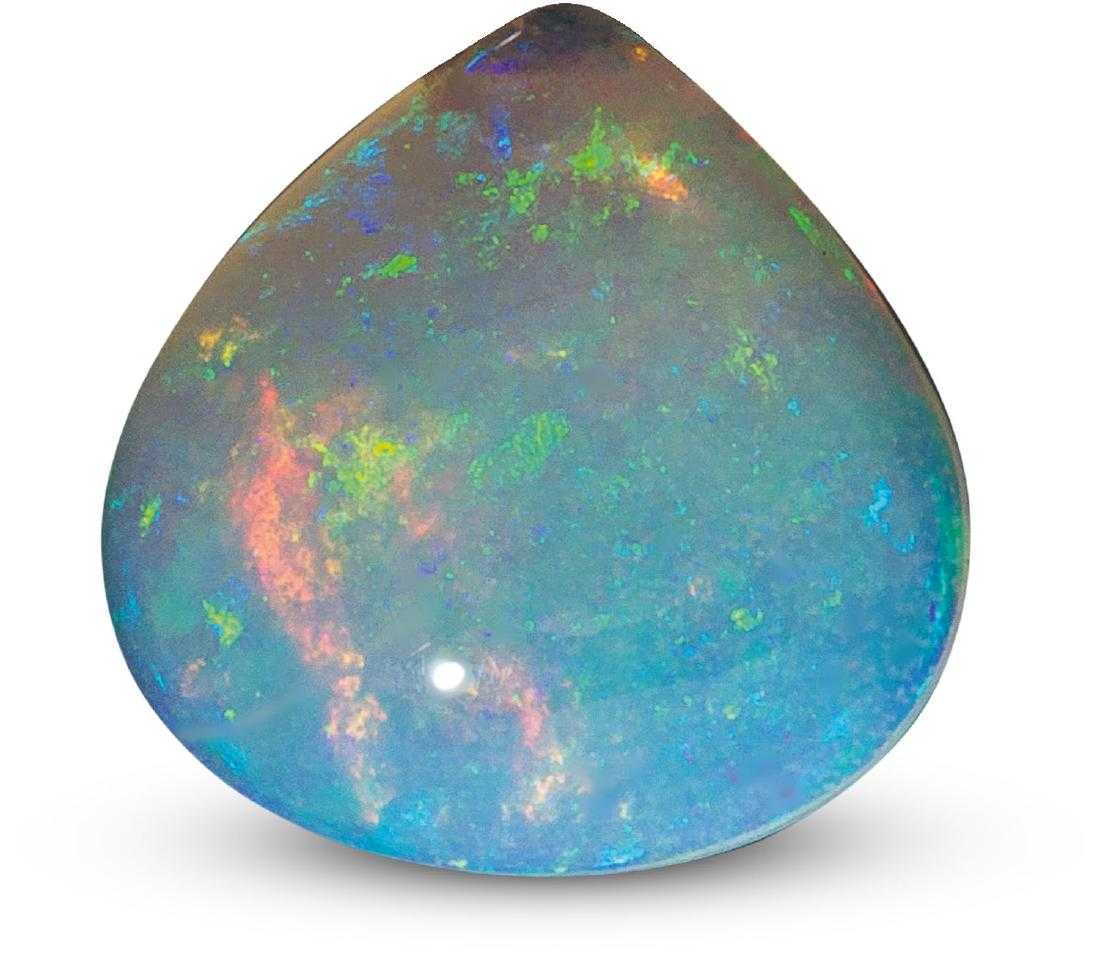Tips for Cabbing and Carving Opals
Opal cabochons can fetch high prices but may be difficult to cut. These tips for carving opals can help gem cutters make the most of these beautiful stones.
3 Minute Read
Carving Opals With Thin Fire Layers
Cutting through a thin layer to expose greater fire is a common challenge when carving opals. I had an opal in my scrap box for years that didn't interest me. One day, after a close inspection, I saw a red broad flash under the pinfire. I didn't much care for the stone as it was, so I decided to cut it deeper.
The picture below shows the stone when I started. The top has been sanded to show fire. At this stage, the opal weighed 6.51 carats. It had no tapering on the sides, and the back wasn't sanded. There was a half-carat waste in shaping this stone, so its maximum size potential was about six carats.
Interested in this topic?
This article is also a part of our Opal Specialist Mini Course, in the unit Introduction to Opals and Their Properties.
Using a Cratex Wheel
I began by simply sanding it on a 600 wheel. The red broad flash became more visible, but I was rapidly losing fire around the edges. Since the fire layers weren't flat, the stone needed to be cut lower in the center. So, I took a wide Cratex wheel and began cutting into the fire layer, working from the center out. (See Cabochon Carving Tools and Techniques for more information on the tools you'll need).
Here is a picture showing the stone about half way through the cutting process. The red flash was becoming more visible. What appeared to be dull areas in the center were where the milky stuff was. There was good fire just a thin ways down.
I kept cutting until I was all the way into the color layer I wanted. With the Cratex, I could easily cut slowly and accurately. When I reached the layer, it was so close to being flat that I could finish it with conventional tools.
The Result
Here you see the finished stone, weighing in at 4.63 carats. I lost some weight around the edges, but half of it is now broad flash red. To my surprise, the red is also a rolling flash! The value of the gem approximately doubled. I like it!
Carving Opals With Surface Potch
Opals often have potch or sandstone inclusions right in the middle of the crown. Here you can see a typical heartbreaker. It has some sandstone between the fire layer and the base and a big patch of sand on top of the fire.
I began by shaping the stone. After removing the majority of the waste, the opal weighed 6.05 carats.
Fortunately, the fire layer was fairly thick. I used a cone-shaped Cratex tool to remove the sand in the middle. It's hard to see in the picture below, but there was now a depression where the sand used to be.
The next step was to finish shaping the stone. I did this with standard cabbing equipment. There was a lot of chipping near the top, so I had to make it quite a bit smaller. When I had the stone sanded and shaped, I pre-polished and polished the depression using diamond on a hard felt cone. Then, I polished the remainder of the stone.
Here's the finished stone, which now weighed 4.52 carats. That's not bad for something that looked like scrap! The sandstone layer is still visible in places but could be hidden with a bezel.
Carving Opals and Combining Gemstones
What could you do with such an oddly shaped gem? Here's one digitally prepared suggestion.
Remember to try different stone pairings and combinations when you need help developing ideas for a cabochon jewelry design. It's worth the effort and could lead to a stunning and original piece.
Here's another heartbreaker from my scrap box I considered using to illustrate techniques for carving opals. This opal has excellent fire, except for a big dead area in the center. (You may find stones with sand holes in their centers, which pose a similar problem).
With a bit of imagination, I can see carving out the center and filling the hole with another gem. Here's the same picture, but with a red spinel digitally added to the center. I haven't actually cut this gem, but this is good inspiration.
It's no secret that hard-to-cut opal cabs sells for the best prices. With your imagination and some carving skills, you can turn some of these bargain stones into first-class jewels.
Donald Clark, CSM IMG
Donald Clark, CSM founded the International Gem Society in 1998. Donald started in the gem and jewelry industry in 1976. He received his formal gemology training from the Gemological Institute of America (GIA) and the American Society of Gemcutters (ASG). The letters “CSM” after his name stood for Certified Supreme Master Gemcutter, a designation of Wykoff’s ASG which has often been referred to as the doctorate of gem cutting. The American Society of Gemcutters only had 54 people reach this level. Along with dozens of articles for leading trade magazines, Donald authored the book “Modern Faceting, the Easy Way.”
Related Articles
Opal Stones and Gems: Value, Price, and Jewelry Information
Opals in the Australian Outback
Gemology Cheat Sheets
Gemstone Doublets, Triplets, and Other Assembled Stones
Latest Articles
800 Years of Mogok: A Celebration in Tenuous Times
What is the Average Gemstone Faceting Yield?
Pyroxmangite Value, Price, and Jewelry Information
How to Identify Emerald Simulants and Synthetics
Never Stop Learning
When you join the IGS community, you get trusted diamond & gemstone information when you need it.
Get Gemology Insights
Get started with the International Gem Society’s free guide to gemstone identification. Join our weekly newsletter & get a free copy of the Gem ID Checklist!
